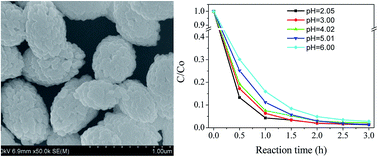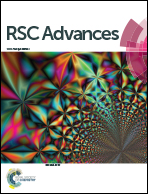Fabrication of an olive-like BiVO4 hierarchical architecture with enhanced visible-light photocatalytic activity
Abstract
The olive-like BiVO4 hierarchical architecture has been synthesized by using a facile, template-free hydrothermal method. With an average diameter of about 0.5–1 μm, the as-prepared olive-like BiVO4 is composed of two dimensional nanoplates with a stacked lamellar arrangement. A possible growth mechanism is proposed based on the characterization results of electron microscopy and X-ray powder diffraction, i.e., cooperative crystallization and a self-assembly synergistic process accompanied by Ostwald ripening. The pH value of the system plays a key role in determining the morphology of the final product. The bandgap of the products decreases gradually with the increase of pH values. Ethylene glycol (EG) molecules can effectively inhibit the growth of BiVO4 crystals, while simultaneously induce preferential orientation growth. Moreover, evaluated by the photocatalytic degradation of methylene blue under visible-light irradiation, the BiVO4 synthesized with EG exhibits higher photocatalytic activity than the one synthesized without EG, which is ascribed to a larger specific surface area and hierarchical architecture.


 Please wait while we load your content...
Please wait while we load your content...